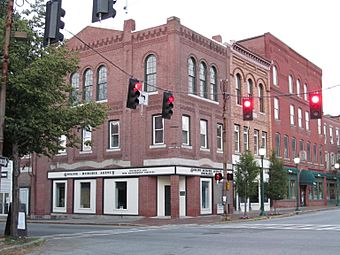Gardiner Historic District (Gardiner, Maine) facts for kids
Quick facts for kids |
|
|
Gardiner Historic District
|
|
 |
|
| Location | Water St., Gardiner, Maine |
|---|---|
| Area | 7 acres (2.8 ha) |
| Architect | Multiple |
| Architectural style | Greek Revival, Late Victorian |
| NRHP reference No. | 80000233 |
| Added to NRHP | May 6, 1980 |
The Gardiner Historic District is a special part of Gardiner, Maine. It shows what the city's main business area looked like in the 1800s. Back then, Gardiner was a busy port and factory town on the Kennebec River. The buildings along Water Street still look much like they did when the city was very successful. This historic area was added to the National Register of Historic Places in 1980.
Contents
Discovering Gardiner's Past
How Gardiner Began
The city of Gardiner started in the late 1750s. A doctor named Sylvester Gardiner was given a large piece of land. This land included all of what is now the city. The town grew around the mouth of Cobbossee Stream. This stream flows into the Kennebec River.
Water Power and Industry
Factories and mills in Gardiner used power from waterfalls on Cobbossee Stream. It was also easy to transport goods on the Kennebec River. By 1850, Gardiner was one of the most important ports on the river. There were eight dams on the stream. These dams powered many different types of factories.
Changes Over Time
In the 1900s, there was less industry and river transport. Because of this, the downtown area from the late 1800s stayed almost the same. This means we can still see many of the original buildings today.
Exploring the Historic District
What You'll See
The Gardiner Historic District includes buildings on both sides of Water Street. This street runs along the south side of Cobbossee Stream. Then it goes south along the western bank of the Kennebec River.
Where the District Is
The district starts at Brunswick Avenue. It goes southeast to the Gardiner Public Library building. This library is at the eastern end of Mechanic Street.
Buildings and Styles
There are 47 historic buildings in the district. Most of them are made of brick. They are usually two or three stories tall. Many buildings are in the Greek Revival or Italianate styles. You can also see some Romanesque Revival and Queen Anne architecture.
A Special Building
The Gardiner Public Library is a great example of the Queen Anne style. It was designed in 1881 by Henry Richards. It's a beautiful building to see in the district.



